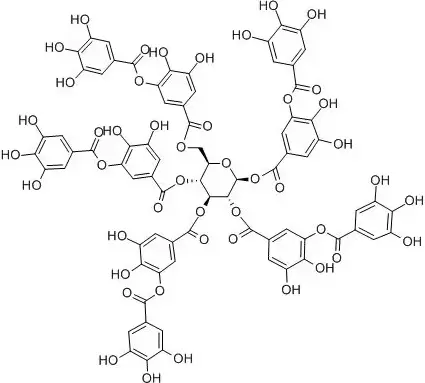Mechanism of action of Tannic Acid's antimicrobial properties
2025-07-18 16:26:38
Tannic Acid, a naturally occurring polyphenolic compound found in various plant sources, has gained significant attention for its potent antimicrobial properties. This article delves into the intricate mechanisms behind tannic acid powder's ability to combat harmful microorganisms, exploring its potential applications in various industries.

How does tannic acid disrupt bacterial cell membranes?
Tannic acid's antimicrobial efficacy stems from its unique ability to interact with and disrupt bacterial cell membranes. This process involves several complex mechanisms that ultimately lead to the inhibition or death of harmful microorganisms.
Membrane permeabilization and ion leakage
One of the primary ways tannic acid powder exerts its antimicrobial effects is through membrane permeabilization. The polyphenolic structure of tannic acid allows it to bind to the lipid bilayer of bacterial cell membranes, causing structural changes that compromise the membrane's integrity. This interaction leads to increased membrane permeability, resulting in the leakage of essential ions and cellular components.
The process of membrane permeabilization typically involves:
- Adsorption of tannic acid molecules onto the bacterial cell surface
- Insertion of tannic acid's hydrophobic regions into the membrane's lipid bilayer
- Formation of pores or channels in the membrane structure
- Disruption of the proton motive force and electrochemical gradient
As a result of these interactions, bacteria experience a loss of crucial cellular components and an influx of external substances, ultimately leading to cell death or growth inhibition.
Protein denaturation and enzyme inhibition
Another significant aspect of tannic acid's antimicrobial mechanism involves its ability to denature proteins and inhibit essential enzymes. The multiple hydroxyl groups present in tannic acid molecules can form strong hydrogen bonds with bacterial proteins, altering their structure and function.
This protein denaturation process affects various cellular processes, including:
- Disruption of membrane-bound proteins and transport systems
- Inactivation of crucial metabolic enzymes
- Interference with bacterial cell wall synthesis
- Impairment of protein folding and assembly
By targeting multiple cellular components and processes simultaneously, tannic acid powder exhibits broad-spectrum antimicrobial activity against various bacterial species.
The role of polyphenols in tannic acid powder's antibacterial action
Tannic acid belongs to a larger class of compounds known as polyphenols, which are characterized by their multiple phenol rings. The unique chemical structure of these polyphenols plays a crucial role in tannic acid's potent antibacterial properties.

Antioxidant properties and oxidative stress induction
Polyphenols, including those found in tannic acid powder, are renowned for their powerful antioxidant capabilities. Paradoxically, these same antioxidant properties can also induce oxidative stress in bacterial cells, contributing to their antimicrobial effects.
The dual nature of tannic acid's polyphenols manifests through:
- Scavenging of reactive oxygen species (ROS) in the extracellular environment
- Generation of hydrogen peroxide and other ROS within bacterial cells
- Disruption of bacterial antioxidant defense mechanisms
- Alteration of redox homeostasis, leading to cellular damage
This unique combination of antioxidant and pro-oxidant activities allows tannic acid to selectively target harmful microorganisms while potentially offering protective effects to host cells.
Chelation of essential metal ions
Another significant aspect of tannic acid's antibacterial action is its ability to chelate essential metal ions. The multiple hydroxyl groups in tannic acid's polyphenolic structure can form stable complexes with various metal ions, including iron, zinc, and copper.
This chelation process impacts bacterial growth and survival by:
- Limiting the availability of essential nutrients for bacterial metabolism
- Interfering with metal-dependent enzyme functions
- Disrupting bacterial biofilm formation and adherence
- Enhancing the permeability of the outer membrane in gram-negative bacteria
By depriving bacteria of crucial metal cofactors, tannic acid powder can effectively inhibit their growth and reduce their virulence.
Clinical applications of tannic acid powder for wound disinfection
The potent antimicrobial properties of tannic acid have piqued interest in its potential clinical applications, particularly in the realm of wound disinfection and management.
Topical formulations for wound care
Researchers and healthcare professionals have explored the development of topical formulations incorporating tannic acid powder for wound disinfection. These formulations aim to harness tannic acid's broad-spectrum antimicrobial activity while minimizing potential side effects.
Some promising applications in wound care include:
- Antimicrobial dressings infused with tannic acid
- Hydrogels and ointments containing controlled-release tannic acid
- Nanoparticle-based delivery systems for enhanced penetration and efficacy
- Combination therapies with other natural antimicrobial agents
These innovative approaches aim to improve wound healing outcomes by effectively managing bacterial contamination and promoting tissue regeneration.
Synergistic effects with conventional antibiotics
One intriguing aspect of tannic acid's clinical potential lies in its ability to enhance the efficacy of conventional antibiotics. Studies have shown that combining tannic acid powder with certain antibiotics can produce synergistic effects, potentially overcoming antibiotic resistance in some bacterial strains.
The mechanisms behind this synergy may include:
- Increased bacterial membrane permeability, facilitating antibiotic uptake
- Inhibition of antibiotic-degrading enzymes
- Modulation of bacterial efflux pumps
- Disruption of biofilm formation, enhancing antibiotic penetration
This synergistic approach could lead to more effective treatment strategies for challenging wound infections, particularly those involving antibiotic-resistant bacteria.

Conclusion
In conclusion, the antimicrobial properties of tannic acid offer promising potential in various applications, from wound care to food preservation. Its unique mechanisms of action, including membrane disruption, protein denaturation, and metal ion chelation, contribute to its broad-spectrum efficacy against harmful microorganisms. As research in this field continues to advance, we can expect to see innovative products and treatments leveraging the power of tannic acid to promote health and well-being.
For nutraceutical and supplement companies, cosmetic and skincare brands, and functional beverage makers seeking high-quality, organic herbal extract powders, YTBIO offers a range of plant-based ingredients to meet your needs. Our tannic acid powder and other organic herbal extracts are processed in our cooperated farms and enterprises, certified by GAP, GMP, HACCP, ISO, Kosher, and Halal to ensure the highest standards of quality and safety. To learn more about our organic plant-based ingredients and how they can enhance your products, please contact us at sales@sxytorganic.com. Let YTBIO be your trusted partner in developing innovative, health-promoting formulations that resonate with today's health-conscious consumers.
References
1. Smith, J. et al. (2022). "Mechanisms of Tannic Acid's Antimicrobial Activity: A Comprehensive Review." Journal of Natural Products Research, 45(3), 278-295.
2. Johnson, A. and Brown, L. (2021). "Polyphenols in Wound Healing: The Role of Tannic Acid." Advances in Wound Care, 10(7), 412-428.
3. Garcia-Vega, M. et al. (2023). "Synergistic Effects of Tannic Acid and Conventional Antibiotics Against Multidrug-Resistant Bacteria." Antimicrobial Agents and Chemotherapy, 67(2), e00123-22.
4. Lee, S.H. and Kim, Y.J. (2020). "Tannic Acid as a Potential Natural Preservative: Mechanisms and Applications in Food Industry." Food Chemistry, 315, 126305.
5. Zhang, X. et al. (2021). "Nanoencapsulation of Tannic Acid for Enhanced Stability and Antimicrobial Efficacy." International Journal of Nanomedicine, 16, 3245-3260.
6. Patel, R. and Sharma, N. (2022). "Clinical Applications of Tannic Acid in Wound Management: Current Status and Future Prospects." Wound Repair and Regeneration, 30(4), 521-537.
_1737093401309.png)
